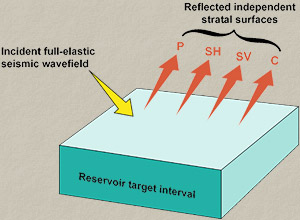Bob A. Hardage, principal investigator; Milo M. Backus, Khaled Fouad, Robert J. Graebner, Jeffrey A. Kane, and Diana C. Sava |
 |
Click
on graphic for larger view and description. |
|
|
The Exploration Geophysics Laboratory (EGL) is partnering
with Fasken Oil and Ranch Ltd. and Vecta
Technology to develop a new seismic interpretation technology, Elastic Wavefield Seismic Stratigraphy.
This technology is based on the physics that each mode of an elastic wavefield can, and often does, image
a suite of stratal surfaces differently than do the other elastic modes. Shear (S) modes can image seismic
sequences and facies not observed in the compressional (P) mode, which is the only elastic-wave mode used in
conventional seismic stratigraphy. In a homogeneous Earth, a full-elastic (9-component) seismic wavefield
yields three S-wave modes: SH-SH (horizontal shear), SV-SV |
|
(vertical shear), and P-SV (converted shear).
In an anisotropic Earth, each of these S modes splits into S1 (fast-S) and S2 (slow-S) modes controlled
by the principal axes of anisotropy. Thus, there is a rich source of stratigraphic information in a
full-elastic wavefield that is not being utilized in conventional P-wave seismic stratigraphy studies.
The objectives of this research are to create compelling examples that prove that different stratal surfaces
are imaged by different elastic-wave modes, to develop systematic relationships between petrophysical
properties and combinations of elastic-mode sequences and facies, and to demonstrate how this new seismic
imaging technology should be applied to improve geologic understanding of oil and gas systems. |
|

